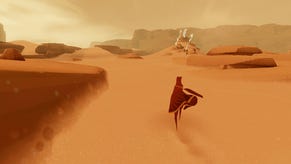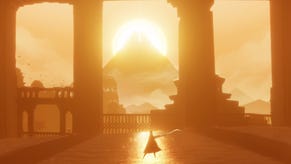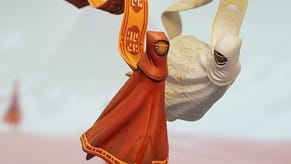Journey
Not the band.
Through some non-linear magic happening deep in his brain - the kind of thing which explains why Chen is a world-renowned game designer while people like me get excited about that fortnightly visit to Burger King - Chen started thinking about games that put you in the position of a worshipper, rather than a god. Games that made you vulnerable rather than powerful, that made you feel part of a wider and confusing world, rather than the chosen one who would bring order to a carefully chaotic landscape.
The result is one of the most intriguing games at E3, and certainly one of the most beautiful. Even without the mountain with that light at the top - an overarching in-game target that, as a plot device, goes right back to the book of Genesis - Journey would have a powerfully religious feel to it, albeit one that's not tied down to any specific belief system.
The game starts with your strange, hooded character, waking up in the midst of an endlessly rolling desert, with nothing but that distant spar of rock to guide you forward. From there, everything from your progress through to social interaction and onto any kind of interpretation is up to you.
If it's the most elaborate game Chen's company has tackled so far, it's also the most tactile. Journey grounds its mystery in down-to-earth concerns like the shifting of sands and the flapping of the protagonist's cloth robes. Both factor into the design of the game's puzzles in fantastical ways, however. Sand ripples in beautifully-rendered waves at the edge of boulders, and can be surfed or ploughed through to create little ridges - helpful, possibly, for communication, or picking up speed for a stunt of some kind - while the cloth plays a crucial role in platforming.

Players can collect little spouts of the stuff pouring out of certain rocks to stay in the air longer after a leap, and can even "tune" themselves to its frequency, via a button press, in order to run across it.
In one section, calling to mind both Zelda and ICO, neither reference quite capturing the exact feeling, three broad ribbons of material are all the player needs to get past a broken bridge to the pathway on the other side. Another hurdle down, another step closer to that haunting, shimmering goal on the horizon.
That's about it for the time being: sand, strangers and a mystery mountain. The result is a game that stands out - stands out so much, in fact, that Sony couldn't find a way to gracefully slide this shard of freeform mysticism in amongst the Coke advertising deals and 3D destruction derbies that characterised its E3 press conference.
While this is almost certainly thatgamecompany's most traditional game yet, it also, somehow, manages to feel like its most ambitious and experimental as well. The final product, if nothing else, should be a multiplayer experience unlike any other.
Maybe.








